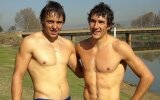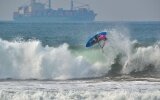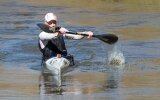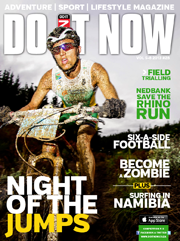- Magazine
- #readityourway
- Weekly Stories
- #shareyourstory
-
Adventure
- Abroad Travelling
- Africa Travelling
- Events
- Expos & Shows
- Festivals
- Fishing
- Free Diving
- Gliding
- Horse Riding
- Inspiring People
- Islands Travelling
- Kite/Windsurfing
- Motorbiking
- Motorised Water Sports
- Mountaineering
- Mountain Biking
- Off-road 4x4
- Off-road Motorbiking
- Paddling
- Performance Driving
- Photography
- Rock Climbing
- Rollerblading
- Sailing
- Scuba Diving
- Skateboarding
- Skydiving
- Snowboarding & Skiing
- Surfing
- Swimming
- Trail Running
- Wakeboarding
- Waveski Surfing
-
Sport
- Adventure Racing
- Fishing
- Free Diving
- Gliding
- Health & Fitness
- Horse Riding
- Inspiring People
- Kite/Windsurfing
- MMA
- Motorbiking
- Mountain Biking
- Multi-sport
- Off-road 4x4
- Off-road Motorbiking
- Paddling
- Performance Driving
- Photography
- Road Cycling
- Road Running
- Rock Climbing
- Rollerblading
- Sailing
- Scuba Diving
- Skateboarding
- Skydiving
- Snowboarding & Skiing
- Surfing
- Swimming
- Rugby
- Trail Running
- Triathlon
- Wakeboarding
- Waveski Surfing
- Lifestyle
- Calendar
River Masters
Words: Rory Penefather | Photos: Various Contributors | Video: D4 Productions, Andrew King
Topic:
Paddling
Canoeing in South Africa has enjoyed good growth over the past decade, but it is in canoe slalom, or slalom as it is commonly known, where the greatest opportunities for growth exist. Practiced by a small group of talented and skilled paddlers, who can out paddle even the fastest Dusi paddler down a rapid, it is the third most popular Olympic sport for spectators.

So what makes canoe slalom so enthralling to participate in or watch? As one of the few extreme Olympic sports, canoe slalom is an adrenalin-fuelled ride down some of nature’s most challenging white water. Paddlers are required to negotiate a course of up to 25 gates, without touching, all the while demonstrating immense skill, stamina, and courage to chance victory. It's fast and exhilarating, and perfect training for running big white-water rivers.
Looking back
The roots of canoe slalom on white water can be traced back to 11 September 1932 in Switzerland. However, when World War II started, just six years after the first canoe slalom competition was held, the development of the sport was set back.
It was only once the war ended that the first Canoe Slalom World Championships, under the patronage of the ICF, was organised in 1949 in Geneva, Switzerland. Thereafter, its history can be broken down into three significant periods.
• 1949-1972 was characterised by dramatic changes. Folding and rigid canvas canoes were replaced with fibreglass reinforced plastic boats at championship events.
• 1972-1992 was filled with changing and simplifying slalom rules, and the hope that slalom would become an Olympic sport again. During this time, there were also dramatic changes in boat construction.
• 1992 to present day signalled the reintroduction of canoe slalom at the 1992 Olympic Games. Further changes were made to the slalom rules, including that of the penalty and two-run system. The sport also saw a massive increase in interest outside of its traditional home of Europe and North America to all other continents. The introduction of the Women Canoe Class in the 2010 World Championship programme heralded another milestone and demonstrated real progression towards gender equity.
Canoe slalom came to South Africa in '80s and since then it has slowly taken off. Today, there are a number of high-profile events littering the calendar, which are attracting an increasing number of local and international athletes. Although growth of the sport in South Africa has been slow due to a lack of suitable facilities for racing and training and South Africa's reliance on rainfall a major factor, this is all set to change because of a renewed focus on developing the sport towards Rio 2016 and the 2020 Olympic Games. The Canoeing South Africa Canoe Slalom Committee has developed a grass-roots plan that will see slalom being brought to all provinces by 2016. It is also being punted as one of the best disciplines to do when starting out because of the skill set that one develops by practising it. Many of the country's top paddlers, like Andrew Birkett, Len Jenkins, and Ant Stott, participated in slalom in their junior days! It is also extremely beginner friendly, as there's always safety on hand and races are generally held on rapids that have a large pool at the bottom.
Getting started
All you need is a boat, paddle, one or two poles to hang above the water, some water, and a stopwatch. Oh, and other people to race against is a handy addition. There are two classes of boats; kayak and canoe. In a kayak, you sit in the boat and use a two-bladed paddle to move forward, while in a canoe you kneel in the boat and use a single-bladed paddle.
Competition categories
Canoe slalom paddlers compete in five categories. For the men there is Kayak Singles (K1), Canoe Singles (C1) and Canoe Doubles (C2). The women race in the Kayak Singles (K1) at the Olympics and Canoe Singles (C1) at non-Olympic events.
Speed and precision
Canoe slalom is an individual time trial down a set course of poles, or gates, which hang above the water. The gates are placed in a specific order and in a certain direction, with green gates being negotiated in a downstream direction and red gates in an upstream direction. If a paddler touches a gate - either with the paddle, boat, buoyancy aid, helmet or any part of their body - they will receive a two-second penalty. If they miss a gate or negotiate it in the wrong direction, a fifty-second penalty is added to their running time - a wipeout in serious competition! The combined score of time and penalties determine the finish order. The course is usually 100 seconds long and can be done on any water, from flat-water dams to the biggest and most powerful artificial Olympic courses. Each participant gets two runs down the course, with the best of these counting towards their final score.
Competition format
Local events normally consist of 10 to 15 gates on easy rapids, while the National Championships usually consist of the full 18- to 25-gate course on more challenging water. International events are always on a full course and on quite challenging white water. After two runs, times are calculated and the top half of the field go through to the semi finals. In the semi finals, paddlers only do one run, which counts towards their ranking. The top ten athletes then go through to the finals, where, once again, only one run counts! The pressure at international events is huge, not only because of the tough competition but because just one touch of a gate can result in a massive drop of ten positions on the leader board! To be one of the 40 boats that qualify for the semi finals at the annual World Championships, racing is incredibly tight, as you are required to be around four seconds off the pace of the leader. Five seconds behind and there's a good chance you won't make it through to the semi finals!

Training centres
There are two major training centres in South Africa, with one in Pietermaritzburg, KZN, and the other in Bethlehem, Free State. In Pietermaritzburg, there is the Camps Drift Flat Water Course for beginners and the Moto-X Wier Course is for the more advanced. In Bethlehem, there is the Bolokong Flat Water Course next to Bolokong Township. This course is also home to the Dihlabeng Canoe Slalom development's project, which was started in 2003 by Beijing Olympian, Dr. Cameron MacIntosh. It is a development project that brought slalom to the community and has produced many national representatives, the most well known being Master Cele and Cyprian Ngidi, Beijing Olympians. Just outside Bethlehem there’s also the mighty Ash River, which plays host to many international athletes in the summer months because of its summer climate and guaranteed water. With the sport being European dominated, when the European winter strikes, many of the world's top paddlers leave in search of warmer climes to paddle in. It is also Africa's biggest slalom course and venue for the annual SA International Slalom Open, sponsored by the Dihlabeng Municipality.
Slalom is also growing in other areas, with start-up projects happening in Uppington, Paarl, and soon in Johannesburg. These projects are all grass-root development projects, where the committee locates suitable facilities for racing and training, and are mainly about teaching beginners the basics about the slalom strokes and the Eskimo roll.
Local talent
In South Africa, we have traditionally always had very good C1 paddlers, and are now starting to see our K1 paddlers also step up to the plate internationally. In the 2008 Beijing Olympics, we had boats represented in the C1 (Master Cele) and C2 (Cameron MacIntosh and Cyprian Ngidi) classes, who finished 16th and 17th respectively. Master and Cyprian still race internationally, and Cyprian also won the South African C1 National title earlier this year.
This month sees the country's best Juniors and U23s jetting off to Slovakia for the IFC Junior and U23 World Canoe Slalom Championships. For the majority of the team, it will be their first real taste of international competition, but a vital learning curve in their careers. Our two U23s, Don Wewege and Success Malahaba, have represented South Africa since 2010 and 2007 respectively and should be knocking on the top 20 door. Our biggest medal hope rests with Don Wewege, the current and three-time South African National Canoe Slalom Champion. Also the highest-ranked South African internationally, he finished off his Junior career last year ranked in the top 30 in the world in the K1 Men’s class. This year, Don will be racing in the U23 category alongside Success Malhaba, his biggest rival for the past few years. Wewege is looking to base himself in the UK from September so that he can train amongst the best in the world, on one of the world's best artificial training centres. This is a huge opportunity for him, as it will exponentially improve his international performances.
Looking forward
Europe has been the hub of slalom since the '50s, and with the onset of purpose-built, artificial facilities being erected mostly there, the Europeans have always been at the top of the world rankings.
Being so far from Europe has a huge impact on our local top athletes' performance because they are not able to compete regularly in Europe due to the high cost factor. As a result, our paddlers are lagging behind the other athletes in terms of race experience, and this in turn negatively affects them when they do race. To help the athletes compete more often internationally, the South African Slalom Committee has been hard at work and secured a few very good sponsors going forward, and hopefully more companies will be interested in helping our future Olympians compete internationally. Wewege looks to be the first of South Africa's top slalomists to make the move overseas, but he still needs to secure funding to help him achieve his goal. The huge tuition costs while attending the University of Nottingham, as well as racing and training fees total almost R200 000 a year, so we are hopeful that a sponsor will come on board to assist him financially - and ultimately help us get our international rankings up.
Is it for you?
Slalom is for everyone. It's the perfect sport for experienced paddlers looking to hone their river paddling skills, and for new paddlers looking for an extreme sport that is very safe or wanting to learn how to read rapids. So whether you are young or old, fit or unfit, canoe slalom could just be the sport for you.
dinFO
For more information on canoe slalom and upcoming
events, visit Canoeing South Africa's page on slalom:
www.canoesa.org.za/canoe-slalom/ or the ICF's slalom site: www.canoeicf.com/icf/Aboutoursport/Canoe-Slalom.html.
To follow South Africa's progress at the IFC Junior and
U23 World Championships, from 17 to 21 July, like the
Slalom SA page on Facebook.
If you are interested in helping Don Wewege achieve his dreams, either email him on or contact Rory Penefather, the Slalom Committee Chairperson, on
|
|
|
|
|
|
|
|
|
|
Issue:
Issue 27 Jul 2013
Related content
|
|
|
|
|
|
|
|
|
|









